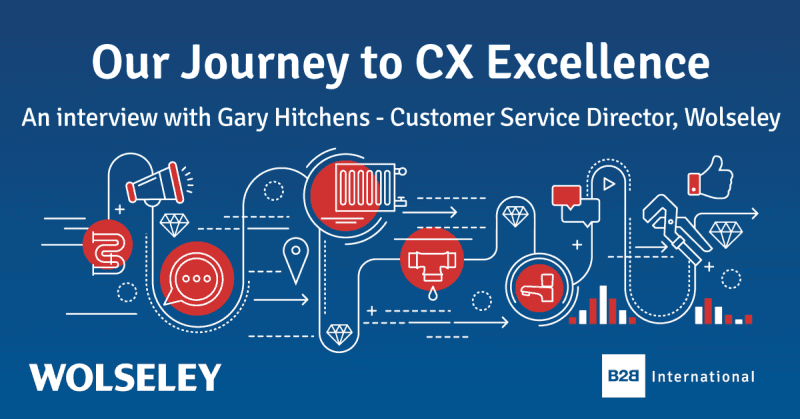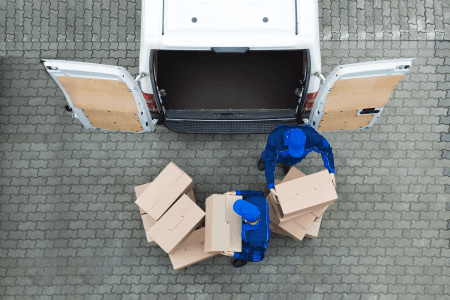
Find more examples, case studies and stories in our latest book
Having conducted hundreds of customer satisfaction and loyalty surveys over the last 20 years, we know first-hand what it takes to deliver CX excellence in b2b markets. Unfortunately, exceptional customer experiences are not as common as they should be, and it is this that drove us to write ‘B2B Customer Experience – A Practical Guide To Delivering Exceptional CX’.
The book is out now and is available to buy here. To celebrate the launch of the book we will be sharing a selection of different interviews with CX professionals, each talking about their own journey towards CX excellence. The fifth of which, with Wolseley’s Gary Hitchens, is below.

Gary Hitchens, Customer Service Director, Wolseley
What does customer experience mean to Wolseley?
Customer experience to me means our ability to meet and exceed customer expectations and that is wherever the customer interacts with us.
How did your customer experience journey start?
The starting point for us was around 2014. The board of Wolseley recognised there was something really big around Net Promoter Score (NPS) and opportunities for growth.
When we started in 2014/15 our aim was to get a baseline on what the customer is experiencing from Wolseley at that time. Also we had people, particularly in our plumbing company, who were getting involved in lots of other aspects of customer experience such as customer segmentation.
We then moved on to think about how we could get some real measures that could help us achieve change. We moved from insight into getting measurements that enabled us to turn the dial on these priorities. This was a step change for us.

We had a change of leadership and this resulted in an acceleration of our customer experience programme with NPS and customer satisfaction being our number one priorities. It also resulted in investment in some of the things we needed to do to improve the customer experience – for example increasing our stock of products against customer needs.
How does b2b customer experience differ to b2c?
Delivering B2B customer experience is fundamentally different to B2C. You are trying to develop long-term relationships. B2B relationships have to trade on long-term relationships. We sell heating systems to plumbing and heating engineers on a daily basis. The consumer, the end-user, might only buy a heating system once every 15 years. In consumer markets you can recover quite quickly because you have a mass-market to deal with. In a business to business environment you’ve got to have a much stronger relationship with all your customers. The B2B customer tends to be more balanced. You don’t see as many fluctuations in a B2B environment. In a B2B environment it’s much more difficult to move people from detractors to passives to promoters.
“Delivering B2B customer experience is fundamentally different to B2C. You are trying to develop long-term relationships.”
What are the biggest challenges you face specific to customer experience?
One of the biggest challenges of our business is to tell our proposition story really really well. It is difficult to get consistent communication of our proposition across the whole of our business. Anecdotes get shared across the company and they become the folklore. These stories on the street become really powerful in the company, even more important than the survey results that we have.
For example, we introduced free coffee in one of our depots and within minutes of this initiative being introduced into a branch it was shared throughout the whole company.
If you have good stories they spread like wildfire and they get adopted. The reverse is also true. If it’s bad news story it gets spread very quickly is very difficult to contain.

The single biggest challenge we have is consistency and reliability. Getting the perfect experience in B2B isn’t a one-off. You have to be able to show, day in and day out, that you value the customer experience. In the B2B environment, one bad experience can completely destroy the customer experience even if the previous 99 were very good. One of the things you’ve got to get right is how you get consistency and how you communicate it across the whole organisation – how you get things right. We have three people at the centre who control the communications throughout the whole organisation. They manage the daily, weekly and monthly communications that go through to the front-line. It stops the front line getting the millions of emails they used to get. They now get them in a controlled way. They get emails each week that tell them how the week should be structured, what they should be doing on certain days. Then there’s a monthly comms that keeps them up to speed with the latest communications. We try to make the message that goes to the front line consistent. The challenge is delivering on the consistency. Telling people to do it is easy. Ensuring that they are consistent is the tricky bit.
“In the B2B environment, one bad experience can completely destroy the customer experience even if the previous 99 were very good. One of the things you’ve got to get right is how you get consistency and how you communicate it across the whole organisation – how you get things right.”
You have recently rebranded all your branches to fall under the Wolseley brand. How you’re your brand fit with your customer experience initiative?
The strengths of the emotional attachment to brand in B2B is stronger than it B2C. Your customer relies on you to deliver things so they can deliver to their customer. If you always do what you said you were going to do and you prove to be reliable, this will drive through to your brand. I think this is even more powerful in B2B than it is in B2C. If someone doesn’t trust you, you are snookered. Often the relationship in B2B is with an individual rather than with the brand. If the company can attach the brand rather than the individual then they have something really powerful. That’s why you’ve got to have a really telling proposition that is communicated in a good way and that is the rationale behind the rebrand to Wolseley. Our customers are built on the expectation of our brand and not just the local Joe in the branch.
Nine out of 10 of our customers receive product from us. The product is vitally important. It is so crucial to reliably deliver to our customers so they can deliver reliably to their customers.
It means that our brand promise is so critical. We have to make our customers more profitable – they need to know that we will always have exactly what they need, we will always price it fairly, and we will make it easy to do business. These are the pillars of the new Wolseley brand.

What advice would you give to others who may be starting out on their customer experience journey?
You always need a clear set of priorities and a set of plans attached to those priorities. No one gets out of bed in the morning and wants to give a bad customer experience. The reason it slips people’s minds is because you might not be raising the bar and letting people know what comes next. In any big business there are always a huge number of initiatives and you need to keep the customer experience initiatives fresh and push people to be better and better, otherwise it falls by the wayside. Last year we drove an improvement even though it was a year of significant change in the business. I’m pleased with that. However, we now need to energise the organisation again to continually improve. We need to get the management to invest in this otherwise they will invest in other things.
“You have to have senior buy in, particularly in a large organisation because there will always be competing priorities. If customer experience isn’t a priority it won’t stick.”
You have to have senior buy in, particularly in a large organisation because there will always be competing priorities. If customer experience isn’t a priority it won’t stick. Secondly, I think the most valuable advice is that trying to do stuff on too larger scale can paralyse an organisation. You have to start small and be clear on what the big ticket items are. But you need to pilot them and get them proven and get local buy in. Once you get buy in, other people want to know when they can have it. If things fail, it is because you don’t have the right sponsorship and you try to do too much at once.
Readers of this article also viewed:
- Our Journey to CX Excellence: an Interview with… Ian Webb, Antalis
- Our Journey to CX Excellence: an Interview with… Jo Ormrod, Coveris
- Our Journey to CX Excellence: an Interview with… David Ward, Yodel
- Our Journey to CX Excellence: an Interview with… Carol Sheppard, Molson Coors
- Go Beyond In Customer Experience – A Conversation With Chris Daffy
- Differentiating An Undifferentiated Product – A Conversation With Dale Grinstead

